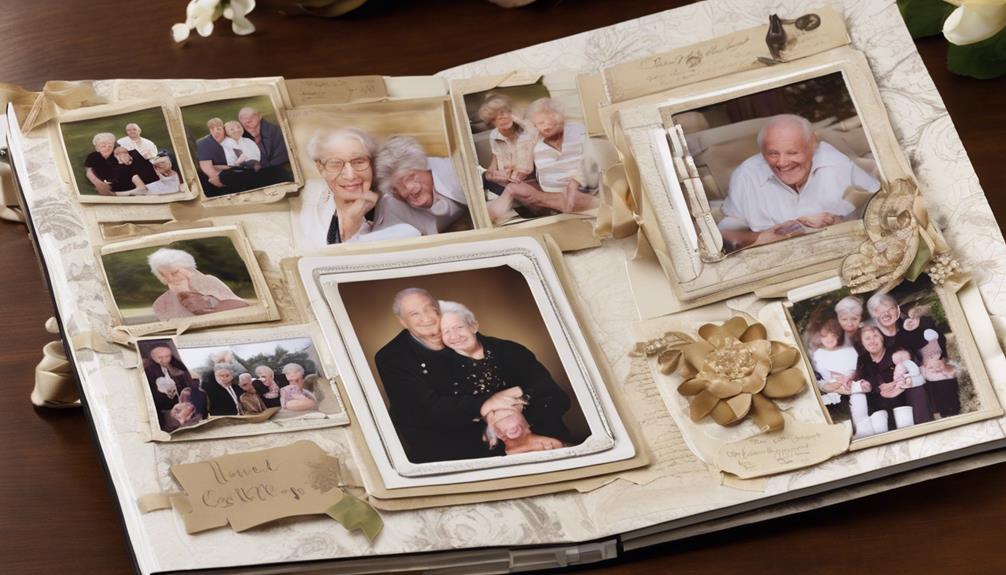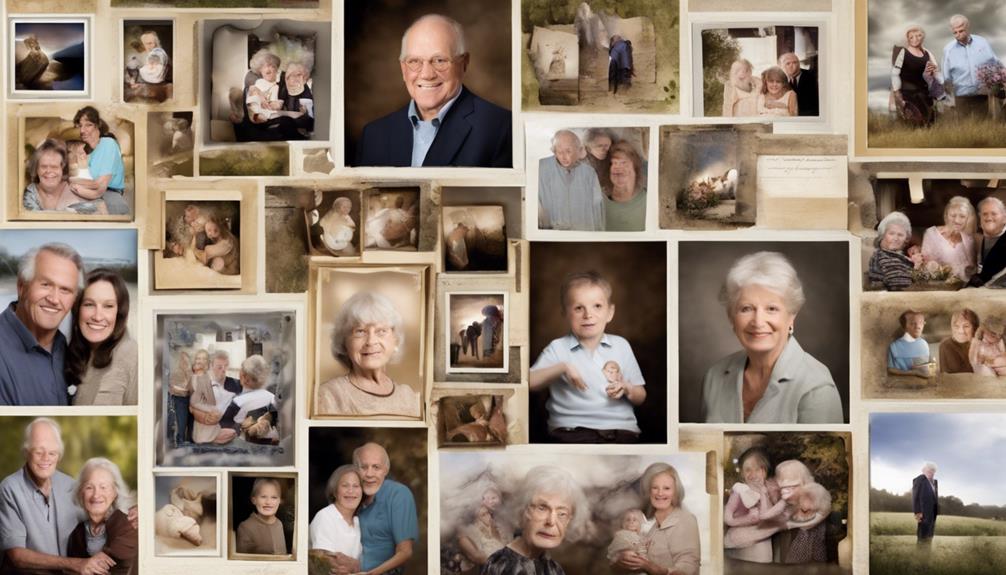Creating a DVD for a loved one impacted by dementia could be the most meaningful way to preserve a lifetime of memories in one physical keepsake.
As we dive into the intricacies of selecting the perfect photos and songs, you'll discover how this personalized journey down memory lane can bridge the gap between past and present, igniting moments of recognition and joy.
Stay tuned to unravel the secrets of creating a heartfelt DVD that not only preserves cherished moments but also fosters a deeper connection with your loved one, sparking conversations and evoking emotions that transcend time.
Key Takeaways
- Nostalgia therapy benefits Alzheimer's and dementia patients.
- Create a cozy, distraction-free space for viewing.
- Select content that reflects cherished memories.
- Engage in activities triggering memories for comfort and connection.
The Power of Nostalgia
When creating a DVD for a loved one with dementia, tapping into the power of nostalgia can evoke cherished memories and emotions, providing comfort and connection. Memories from the past hold a special place in our hearts, and for individuals with dementia, these memories can be a source of joy and familiarity. Engaging in activities that trigger these memories can help bridge the gap between the past and the present, allowing your loved one to reminisce about happier times.
Dementia can often make it challenging for individuals to recall recent events, but memories from years gone by tend to remain intact. By incorporating old pictures, music, and storytelling into the DVD, you can create a treasure trove of nostalgia that brings comfort and happiness to your loved one. Nostalgia therapy has shown remarkable benefits for Alzheimer's and dementia patients, helping them feel more at ease and connected to their identity. So, as you craft this DVD, remember the power of nostalgia in unlocking precious memories and emotions for your loved one.
Step-by-Step Guide

As we embark on the journey of creating a memory DVD for a loved one with dementia, our first crucial step is gathering photographs and videos to capture cherished moments and create a meaningful experience. This process can be emotional, so remember to take breaks and care for yourself throughout.
Here are some tips to guide you through this journey:
- Handle Memories with Care: Treat each photograph and video clip as a precious memory, honoring the stories they hold.
- Embrace Emotions: Allow yourself to feel the nostalgia and love that come with revisiting these moments.
- Create a Safe Space: Set up a cozy, quiet area where you can immerse yourself in the memories without distractions.
- Celebrate Every Moment: Recognize the importance of this activity in connecting with your loved one and creating lasting memories.
Each step you take in this process is a meaningful activity, not just for your loved one but also for you. Embrace the journey down memory lane with compassion and dedication.
Choosing the Right Content
To curate a memory DVD that resonates deeply with your loved one with dementia, carefully selecting photos and videos that hold significant sentimental value is essential. When choosing the right content, focus on incorporating images and videos that reflect past events and cherished memories shared with loved ones. These visuals can serve as powerful triggers, taking your loved one on a heartfelt journey back in time. Including moments from family gatherings, special occasions, and vacations can evoke a sense of nostalgia and connection to their past.
Additionally, integrating music that's meaningful to your loved one can enhance the emotional impact of the DVD. Songs that resonate with their past experiences and emotions can help create a comforting and familiar atmosphere. Organize the content in a coherent manner, either chronologically or thematically, to weave a compelling narrative that guides them through the journey of 'Taking a Trip' down memory lane. By carefully selecting content that's engaging, positive, and tailored to their preferences, you can ensure a truly meaningful viewing experience for your loved one.
Personalizing the DVD

Let's now focus on personalizing the DVD to create a truly meaningful and engaging experience for your loved one living with dementia. When crafting the DVD for your loved one's journey down memory lane, consider these emotional touches:
- Selecting photos and videos that hold special memories can bring a sense of familiarity and comfort.
- Incorporating their favorite music won't only enhance the viewing experience but also help evoke cherished memories.
- Adding recorded messages or voiceovers can establish a personal connection and convey love and warmth.
- Organizing the content chronologically or by themes can help create a cohesive narrative that resonates with your loved one.
Editing and Finalizing
When finalizing the DVD for your loved one with dementia, ensure that the transitions, music, and effects are thoughtfully added to enhance their viewing experience. These elements can help create a seamless and engaging journey through the memories captured on the DVD. It's crucial to keep in mind that individuals living with Alzheimer's may have varying levels of cognitive abilities, so simplicity and clarity in editing are key.
As family members, we've the opportunity to create a personalized and meaningful viewing experience for our loved ones. By carefully arranging photos and videos in a coherent manner, we can help them follow along and connect with the content on a deeper level. Adding personalized touches like captions or recorded messages can also make the DVD more engaging and emotionally resonant.
Before finalizing the DVD, it's essential to double-check for any errors or inconsistencies. Ensuring that the menu is easy to navigate will make the viewing experience more enjoyable for your loved one. By putting in this extra effort during the editing and finalizing process, we can create a special keepsake that brings joy and comfort to our family member with dementia.
Frequently Asked Questions
How Can I Ensure That the DVD Will Be Easy for My Loved One With Dementia to Navigate and Use?
To ensure the DVD is easy for our loved one with dementia to use, let's keep it simple.
We should organize it into clear sections with large, easy-to-read labels. Using familiar pictures or symbols can also help them navigate.
Including familiar music or voices can provide comfort and aid in recognition.
Lastly, we can test the DVD with our loved one to make sure it's user-friendly and enjoyable for them to use.
Are There Any Copyright Issues I Need to Be Aware of When Selecting Content for the Dvd?
Absolutely, it's crucial to consider copyright issues when selecting content for the DVD. We must be mindful of using only materials that we've the rights to, to avoid any legal complications.
It's essential to prioritize the well-being of our loved one and ensure that the process of creating the DVD is done ethically and respectfully. Let's make sure we gather content that brings joy and comfort without infringing on any copyrights.
What Are Some Tips for Creating a Calming and Comforting Viewing Experience for My Loved One With Dementia?
Creating a calming and comforting viewing experience for our loved one with dementia involves selecting familiar, soothing content. Keep lighting soft, minimize background noise, and offer gentle reassurances throughout.
Incorporate favorite music or nature scenes to evoke positive emotions. Ensure the environment is cozy and free of distractions. Watching together can also provide a sense of security and connection.
These small adjustments can make a big difference in their overall well-being and enjoyment.
How Can I Involve Other Family Members in the Process of Creating the Dvd?
We can involve other family members in creating the DVD by assigning different tasks based on their strengths and interests. Some can gather photos, others can write heartfelt messages, and a few can help with editing. By sharing the workload, we ensure everyone contributes in a meaningful way.
Encouraging open communication and collaboration allows us to create a personalized and touching DVD that truly reflects our loved one's life and journey.
Are There Any Special Considerations I Need to Keep in Mind When Presenting the DVD to My Loved One With Dementia for the First Time?
When presenting the DVD to our loved one with dementia for the first time, we should create a calm and familiar environment.
It's important to be patient, allowing them time to process the information. Using gentle reminders about who's in the video and the memories shared can help orient them.
Keep the viewing session short to prevent overwhelming them. Remember, the goal is to bring joy and connection through the shared memories.
Conclusion
In conclusion, crafting a DVD for a loved one with dementia is a meaningful way to share memories and create moments of connection. By taking a trip down memory lane together, we can evoke emotions, spark recognition, and strengthen bonds that transcend time.
So why not take the time to preserve precious memories and create a lasting keepsake that will bring comfort and joy for years to come?









